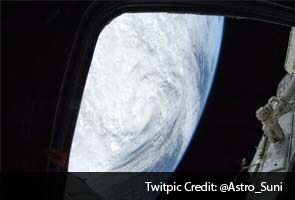
Houston:
Superstorm Sandy looks enormous even when seen from space, Indian-American astronaut Sunita Williams said as she prepared to add to her record-setting space walking sojourns.
Ms Williams is gearing up for another spacewalk scheduled for Thursday to find and repair an ammonia coolant leak at the International Space Station (ISS).
"The superstorm that has been ravaging the East Coast is enormous, even when seen from space", Ms Williams, commander of the International Space Station, said on Wednesday.
Ms Williams said that she and her crew members were able to make out the big swirl at the centre of Sandy as it neared land on Monday.
The cloud cover stretched from the Atlantic almost all the way to Chicago.
"It's pretty huge and hope everybody down there is safe and sound," Ms Williams said
Tomorrow, Ms Williams will add to her record of the world's most experienced spacewalking woman. She and a crewmate will venture out on a spacewalk to find and repair an ammonia coolant leak on the ISS.
The leak is tiny, the equivalent to a hole about the diameter of a human hair.
But if it is not bypassed or repaired, the coolant in the channel 2B solar array will drop below safety margins over the next few months, taking down a critical power channel.
In a bid to locate the leak, Expedition 34 commander Ms Williams and Japanese astronaut Akihiko Hoshide will suit up and venture outside the station to operate a valve and reconfigure coolant lines, isolating the part of the channel 2B coolant loop that snakes through a large folding radiator.
Then they will deploy a spare radiator used during the early stages of space station assembly and route the channel 2B coolant through the older panel.
If the leak ultimately goes away -- and it likely it will take several weeks to find out -- engineers will know the problem was in the original radiator, most likely the result of a space debris impact.
In that case, station managers could opt to use the older radiator indefinitely, solving the problem.
If the leak continues, however, they would have to consider replacing a pump module or taking more extensive steps in a future spacewalk.
Ms Williams is gearing up for another spacewalk scheduled for Thursday to find and repair an ammonia coolant leak at the International Space Station (ISS).
"The superstorm that has been ravaging the East Coast is enormous, even when seen from space", Ms Williams, commander of the International Space Station, said on Wednesday.
Ms Williams said that she and her crew members were able to make out the big swirl at the centre of Sandy as it neared land on Monday.
The cloud cover stretched from the Atlantic almost all the way to Chicago.
"It's pretty huge and hope everybody down there is safe and sound," Ms Williams said
Tomorrow, Ms Williams will add to her record of the world's most experienced spacewalking woman. She and a crewmate will venture out on a spacewalk to find and repair an ammonia coolant leak on the ISS.
The leak is tiny, the equivalent to a hole about the diameter of a human hair.
But if it is not bypassed or repaired, the coolant in the channel 2B solar array will drop below safety margins over the next few months, taking down a critical power channel.
In a bid to locate the leak, Expedition 34 commander Ms Williams and Japanese astronaut Akihiko Hoshide will suit up and venture outside the station to operate a valve and reconfigure coolant lines, isolating the part of the channel 2B coolant loop that snakes through a large folding radiator.
Then they will deploy a spare radiator used during the early stages of space station assembly and route the channel 2B coolant through the older panel.
If the leak ultimately goes away -- and it likely it will take several weeks to find out -- engineers will know the problem was in the original radiator, most likely the result of a space debris impact.
In that case, station managers could opt to use the older radiator indefinitely, solving the problem.
If the leak continues, however, they would have to consider replacing a pump module or taking more extensive steps in a future spacewalk.
Track Latest News Live on NDTV.com and get news updates from India and around the world

